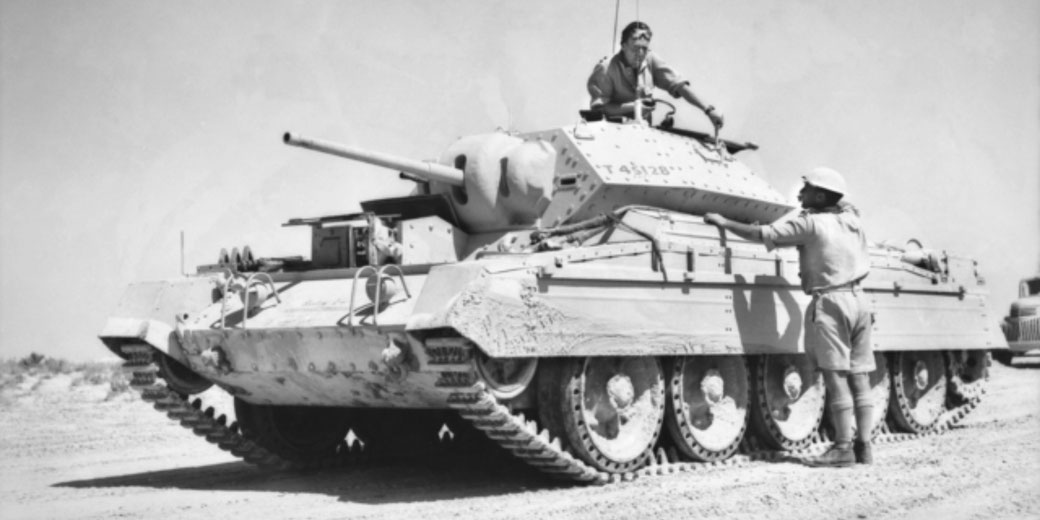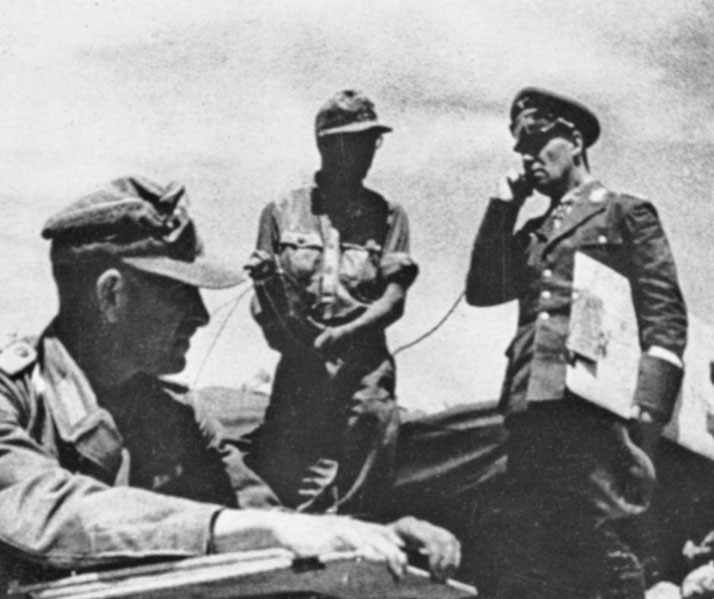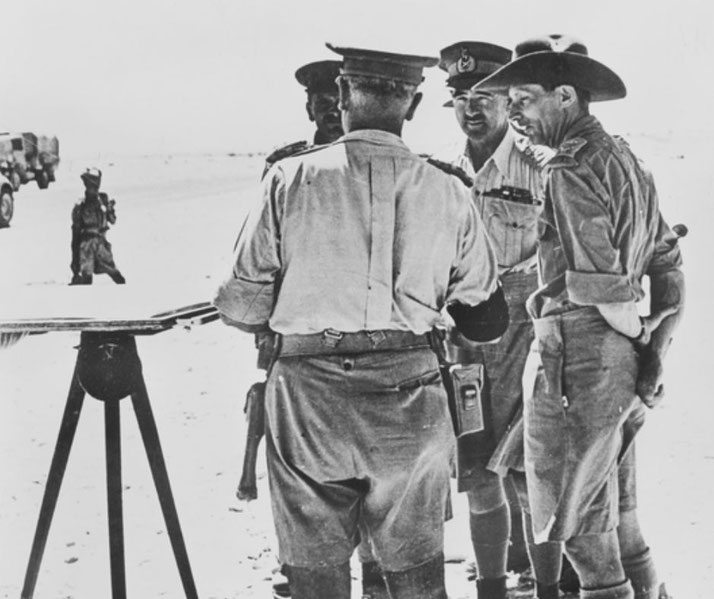Rommel vs. Montgomery: The epic battles of WWII in North Africa

Even though most people think of Europe when discussing World War Two, it was a truly global war, and one of the most hotly contested locations was in the northern region of the African continent.
The vast, windswept sands became the battleground for an epic confrontation between Field Marshal Erwin Rommel and General Bernard Montgomery.
Victory in North Africa meant control over the Suez Canal, the lifeline of the British Empire, and domination of the Mediterranean, a critical artery for military supplies.
Why north Africa was important during WWII
This area was of important strategic value because it bordered the Mediterranean Sea, which was crucial for shipping supplies to armies for both sides of the war.
Also, the Mediterranean was especially vital for the British Empire's communication and supply lines to its colonies and dominions in Asia and Africa.
As a result, the nation who controlled these shipping lanes had an advantage.
At the beginning of the war, Italy controlled parts of northern Africa. However, Britain controlled Egypt, the area that contained the Suez Canal.
This canal was the main shipping route that connected the Mediterranean to the Indian Ocean.
This was where Britain shipped in most of its oil and fuel supplies to keep their vehicles, aircraft and ships running.
Mussolini's invasion of north Africa
On the 11th of June 1940, Italian dictator, Benito Mussolini, declared war on Britain and France.
It wasn't until the 13th of September that the Italian army launched an invasion of Egypt from the neighbouring region of Libya.
In fact, the Italian 10th Army had advanced to Sidi Barrani, which is about 65 miles (105 kilometers) into Egyptian territory.
There was a real threat of losing Egypt, and so the British quickly arranged a counter-offensive.
It was known as Operation Compass and began on December 8, 1940, under the command of General Sir Archibald Wavell.
It was incredibly successful and led to a sweeping victory that pushed the Italians back to Libya and captured nearly 130,000 prisoners.
Finally, Britain achieved a crushing victory in a battle at El Agheila on the 7th of February 1941.
Nine entire Italian army divisions were destroyed, leading to the capture of 130,000 Italian soldiers.
This devastating defeat handed the control of large sections of north Africa to Britain and appeared to show that Italy, which was one of Nazi Germany's main allies, was on the verge of collapse.
If Italy was so quickly defeated, Hitler would be incredibly vulnerable in Europe.
How Hitler sent military help to Mussolini
Hitler moved quickly to support his ally. The German army created a new force called the Afrika Korps and were put under the command of Major-General Erwin Rommel.
On the 11th of February 1941, the Afrika Korps landed at Tripoli in Libya. Very quickly, the British found that they couldn't win as easily against the Germans.
On the 24th of March 1941, Rommel launched his attack towards to Egypt beginning with the recapture of Cyrenaica in Libya.
Thanks to his use of lightning-fast attacks and flanking maneuvers, the Germans quickly forced the British into a retreat.
By the 13th of April, the British had been forced back to the Egyptian border.

The speed of Rommel's advance left British troops, including an Australian Division, trapped in the coastal city of Tobruk, under siege.
These Commonwealth forces held the port for over seven months, all the while enduring constant German and Italian attacks.
Two attempts by British forces to save them failed. Rommel launched his own attack on Tobruk but was also unable to capture it.
However, by this time the Germans had moved too far ahead of their supply lines, which meant that their tanks and vehicles were running out of fuel.
Their attack had to pause while they waited for more, which gave the British time to prepare.
On November 18, 1941, the Allies launched Operation Crusader, a large-scale Allied offensive aimed to relieve Tobruk and drive Rommel’s Afrika Korps back into Libya.
Under General Sir Claude Auchinleck’s command, the British Eighth Army moved west against Rommel’s forces but encountered fierce resistance.
By late November, Rommel’s forces started to falter and, on November 27, the siege of Tobruk was finally broken when Allied tanks and infantry pushed through the Axis lines to finally make contact with the besieged garrison.
This was the first time Rommel had been decisively defeated and the defenders had held out for an incredible 242 days.
Operation Crusader officially ended on December 30, 1941, with the Axis pushed back to El Agheila, deep in Libya.
Though the victory came at a high cost, it restored morale among the Allied troops and demonstrated that Rommel’s forces could be defeated.
Rommel's second attempt to reach Egypt
The German retreat in December allowed Rommel to reconnect with his supply lines.
So, in January 1942, he decided to try to force his way through to Egypt again. It was the British who were now too far away from their supply lines and quickly retreated back to Egypt.
Rommel's new offensive was able to push further east than the first attack and it seemed like the British were unable to stop him.
There was an attempt to halt Rommel in May 1942 at a defensive line between Gazala in the north and Bir Hacheim in the south.
However, after two weeks of heavy fighting, the Germans broke through and kept moving towards Egypt.
The Allied troops were forced to retreat, allowing the Afrika Korps to quickly capture a series of towns, including Tobruk after only a short period of fighting between the 17th and 21st of June 1942.
After the capture of Tobruk, Rommel was promoted to Field Marshal by Adolf Hitler, which made him the youngest German officer to hold that rank at the time.
Rommel reached the border of Egypt at El Alamein and was finally forced to halt when he lost the First Battle of El Alamein in July 1942.
Despite the victory, the British troops were disheartened and disorganised.
The British government, however, felt that their forces in Egypt needed a new commander.
Churchill himself personally flew to Cairo in August 1942 and replaced Auchinleck with Lieutenant-General Bernard Montgomery.
Montgomery quickly reorganized, retrained, and significantly reinforced his forces in order to improve morale.
Then, in late August of 1942 Rommel made one last attempt to cross into Egypt at Alam Halfa, but was too short of fuel and was pushed back.
For nearly two months, Rommel tried to improve his fuel supply lines, with limited success.
This meant that there was little fighting, which gave Montgomery time to retrain and re-equip the British forces.

The Second Battle of El Alamein
Finally, on the evening of the 23rd of October 1942, at 9:40 pm, Montgomery launched a massive artillery from over 800 guns and an air bombardment against the German forces.
This was the start of the Second Battle of El Alamein. It would take ten days of fighting, with both Rommel and the British using flanking tactics and drawing upon all of their reserves.
The Afrika Korps started the battle exhausted and short on supplies, but still mounted a tenacious defense.
By October 25, Montgomery’s forces had gained ground, but progress was slower than expected due to the resistance of Rommel’s experienced Panzer divisions.
Over the following days, the battle became a grinding contest of attrition.
The British Eighth Army, numbering around 220,000 men and supported by nearly 1,000 tanks, kept up relentless pressure.
Rommel’s army was outnumbered and with fewer than 500 operational tanks, struggled to hold their ground.
However, Montgomery's careful preparation ensured that the British had sufficient reinforcements to sustain the attack, and by October 27, the Axis forces were beginning to feel the strain.
On November 2, Montgomery launched Operation Supercharge, a final push designed to break through the Axis defenses completely.
This concentrated armored thrust overwhelmed the remaining German and Italian units, forcing Rommel to order a retreat.
By November 4, the Afrika Korps had been pushed back, leaving behind over 30,000 Axis casualties, including more than 9,000 prisoners.
Operation Torch and eventual Allied victory
By November 6, 1942, the Axis had withdrawn from El Alamein and headed toward El Agheila, which was a defensible coastal position along the Gulf of Sirte. Rommel hoped this location would allow his forces to regroup.
However, his army was facing a growing logistical crisis, as they struggled to maintain supplies, particularly fuel.
By early December, Montgomery’s forces had advanced over 1,400 miles and had reclaimed towns such as Tobruk and Benghazi.
Then, on December 13, 1942, the British reached El Agheila. Recognizing the impossibility of holding the line, Rommel ordered another retreat on December 18.
His forces continued west toward Tripoli, which meant that they had abandoned their last significant defensive position in eastern Libya.
At the same time as the Second Battle of El Alamein, on the 8th of November 1942, the Allies had landed a new force in Morocco and Algeria.
The invasion force, made up mostly of British and newly arrived American forces, was codenamed Operation Torch.
The US troops were commanded by General Dwight Eisenhower and they started marching towards Tunisia.
By the 20th of March 1943, Eisenhower and the British forces had joined up and surrounded the city of Tunis.
On the 7th of May, they broke through and entered the city. Five days later more than 275,000 German and Italian troops surrendered.
This finally brought to an end the North African campaign.
What do you need help with?
Download ready-to-use digital learning resources
Copyright © History Skills 2014-2025.
Contact via email
With the exception of links to external sites, some historical sources and extracts from specific publications, all content on this website is copyrighted by History Skills. This content may not be copied, republished or redistributed without written permission from the website creator. Please use the Contact page to obtain relevant permission.





